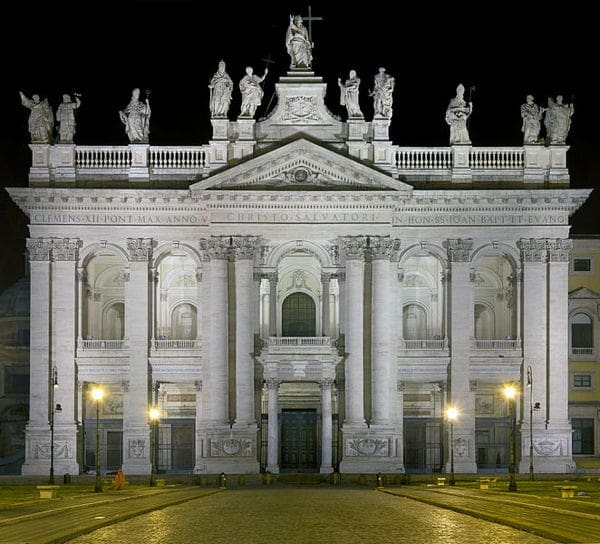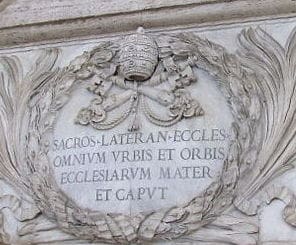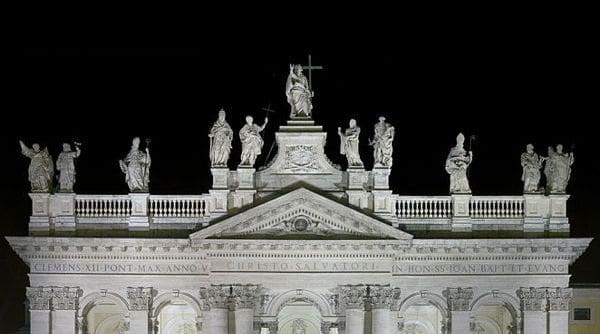Feast of the Dedication of the Lateran Basilica in Rome

“I have chosen and consecrated this house, says the Lord,
that my name may be there forever.”+
2 Chronicles 7:16
The Archbasilica of St. John Lateran is the oldest and most important of the four Major Papal Basilicas in the Catholic Church. And, it is this because it is the seat, or cathedra, of the Pope, the Bishop of Rome. The present basilica stands on the site of an ancient palace on the Caelian Hill (one of the famous seven hills) of Rome which formerly belonged to the family of the Laterani. This palace was part of the dowry of Fausta, the wife of the Emperor Constantine; and, Constantine gave it to the Church* when he converted a portion of the Laterani palace to serve as the papal residence.** The original dedication in 324 A.D. was to the Redeemer (S. Salvator–see the words [Christo Salvatore] in the picture above); but after destruction by an earthquake in 896 A.D., the church was rebuilt by Pope Sergius III (904–11), who dedicated it to St. John the Baptist.
“The anniversary of the dedication of the Lateran Basilica, which was erected by the Emperor Constantine, has been observed on this day since the 12th century. This feast was at first observed only in Rome but later in honor of the basilica, which is called the mother church of Christendom, the celebration was extended to the whole Latin Church. This action was taken as a sign of devotion to and of unity with the Chair of Peter which, as Saint Ignatius of Antioch wrote, ‘presides over the whole assembly of charity.’”***

After the fire of 1308, it was restored by Pope Clement V (1305–14); but it was again burnt down in 1361. The present church was built under the direction of a succession of Popes beginning with Pope Urban V.* St. John Lateran has been host to a number of Lateran councils (some ecumenical) from the 7th to the 18th centuries.* Very fittingly, two inscriptions on the façade say that it is is “the Mother and Head of all Churches, in the City and of the World” (see picture on the right). It’s commonly known as St. John Lateran because it was dedicated to both St. John the Baptist and St. John the Evangelist (see inscription on picture above)** as well as to our Savior. It is located outside of Vatican City, but retains all the diplomatic status of the Vatican as an extra-territorial property of the Holy See.
Meditation:
In honor of today’s very special festival, then, we offer this meditation:****
All of us who believe in Christ Jesus are said to be living stones, according to the words of Scripture: But you are living stones, built as a spiritual house in a holy priesthood, that you may offer spiritual sacrifices acceptable to God through Jesus Christ [cf 1 Peter 2:5].
When we look at an earthly building, we can see that the larger and stronger stones are the first to be set in place as the foundation, so that the weight of the whole structure may rest on them securely. In the same way understand that some of the living stones become the foundation of the spiritual building. What are these living stones placed in the foundation? They are the apostles and prophets. That is what Paul says when he teaches: We have been built upon the foundation of the apostles and prophets, with our Lord Jesus Christ himself as the cornerstone [cf Ephesians 2:20].
You … must learn that Christ himself is also the foundation of the building we are now describing, so that you may prepare yourselves more eagerly for the construction of this building and become stones that lie closer to the foundation. As the apostle Paul says: No foundation can be laid other than the one that has been laid already: I mean Christ Jesus [cf 1 Corinthians 3:11]. Blessed are those, therefore, who build a religious and holy structure upon such a noble foundation.
In this building of the Church, there must also be an altar. I think that if those of you, disposed and eager for prayer, offer petitions and prayers of supplication to God day and night, you will become the living stones for the altar which Jesus is building.
Consider what praise is ascribed to these stones which make up the altar. The lawgiver Moses said that the altar was to be made of stones, uncovered by iron [cf Deuteronomy 27:5]. What are those stones? Perhaps those uncut and undefiled stones are the holy apostles, all making a single altar, because of their unity of mind and heart. For it was known that with one accord they all opened their lips to pray: You, Lord, know the hearts of all [Acts 1:24].
Therefore, these who were able to pray with one mind, one voice and one spirit, are perhaps worthy to form together one altar, where Jesus may offer his sacrifice to the Father.
Let us strive to agree among ourselves and to have one mind and voice. May we never quarrel or act from vainglory. But may we remain united in belief and purpose. Then even we may hope to become stones fit for the altar.
+ Gospel Acclamation for the Feast of the Dedication of the Lateran Basilica in Rome; courtesy USCCB Daily Readings for November 9.
* cf Cross, F. L., & Livingstone, E. A. (Eds.). (2005). In The Oxford dictionary of the Christian Church (3rd ed. rev., p. 958). Oxford; New York: Oxford University Press.
** cf Tylenda, J. N. (2003). Saints and Feasts of the Liturgical Year (p. 239). Washington, D.C.: Georgetown University Press.
***From the Liturgy of the Hours précis for the celebration of the feast.
****Liturgy of the Hours Common of the Dedication of a Church, Second Reading, from a homily on Joshua, son of Nun, by Origen, priest (Homilia 9, 1-2: SC 71, 244-246).
+
Art for this post on the Feast of the Dedication of the Lateran Basilica: Archbasilica of St. John Lateran HD, Livioandronico2013, 21 April 2015, CCA-SA; “Sacrosancta Lateranensis ecclesia omnium urbis et orbis ecclesiarum mater et caput”, incised in the front wall of the basilica, Laurel Lodged, 1 April 2010, PD-Worldwide; both Wikimedia Commons.





